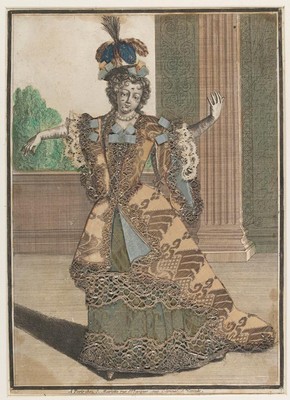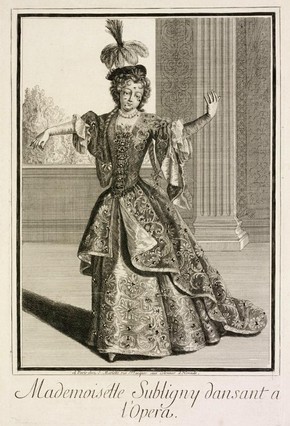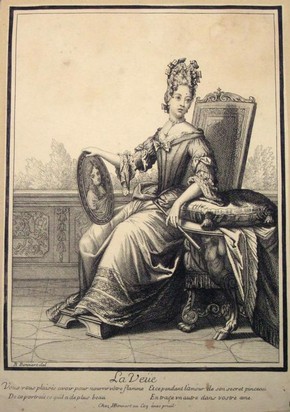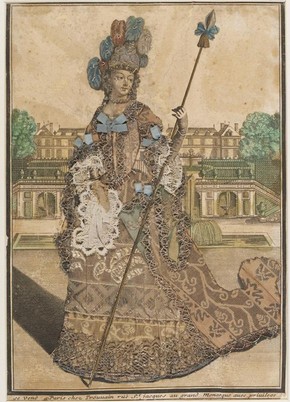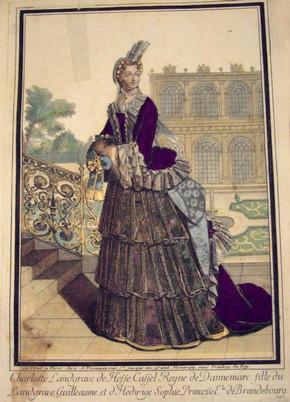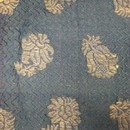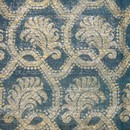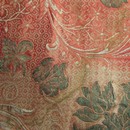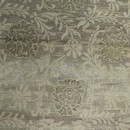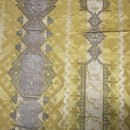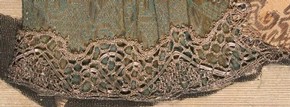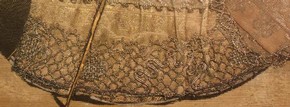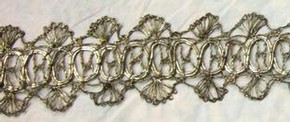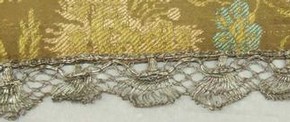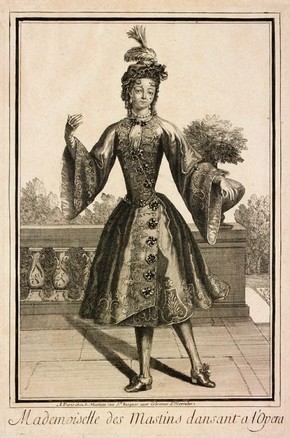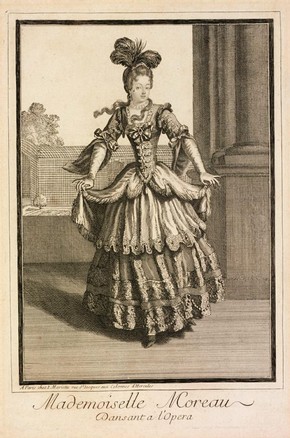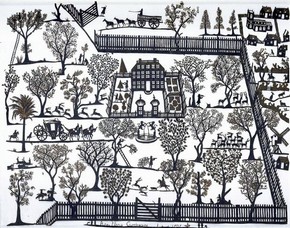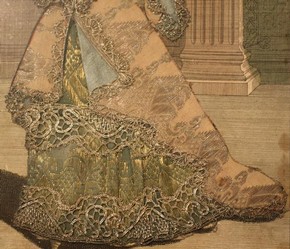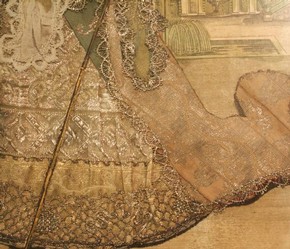V&A Online Journal
Issue No. 3 Spring 2011
ISSN 2043-667X
An adorned print: Print culture, female leisure and the dissemination of fashion in France and England, around 1660-1779
RCA/V&A MA in History of Design
Abstract
Marie-Thérèse Perdou de Subligny (1666-1735) was one of the first opera dancers, with a career that began in around 1688. Her presentation in an adorned engraved print (fig.1) provides an ideal platform for the discussion of cultural life between 1660 and 1779, bringing together diverse issues such as the production and consumption of French prints, opera, celebrity, the dissemination of fashion and female domestic craft. This paper sets the Subligny print in its cultural contexts, and rejects the notion that decorated engravings such as this one, disseminated contemporary fashions.
An adorned print of Marie-Thérèse Perdou de Subligny (1666-1735)
Prints adorned with fabrics have largely been treated as extensions of the ‘fashion plate’, by historians, but this terminology fails to do justice to their complexity. (1) American museums have favoured the term ‘dressed plates’, but this phrasing too belies the complexity of the object, suggesting only a surface alteration, when, in fact, the majority of the decoration was placed underneath the print. (2) This article will use the terms ‘adorned prints’, ‘modified prints’ and ‘decorated prints’, although like ‘fashion plate’ and ‘dressed plate’, none of these terms were used by contemporaries.
Jean Mariette (1660-1742), printer, published the Subligny print in the late 17th or early 18th century. It was enhanced by the careful cutting out of sections of the dress and placing of silks behind the print to fill the gaps. Additional hand colouring was applied, further panels were cut out and textiles were placed behind and on top of the print, while a sheet of paper was attached behind. Ribbons were also placed into slits in the print. Silks were layered to create texture. Silver and white bobbin lace was attached around the sleeves and at the edges of the dress. These modifications could have been made at any point between 1688, when the first edition of the print appeared (it is not clear if this version is the first edition), and its acquisition by the V&A in 1875. X-Ray Fluorescence analysis has revealed that the gold-coloured paint on the feathers is brass paint, while a small painted line above Subligny’s shoe is tin paint, but both substances were used for centuries. (3) Further scientific analysis using RAMAN to discover which pigments were used to colour the print, and thereby narrow the date range for the print’s decoration is possible, but has not yet been done. Combined with the difficulties inherent in dating silks conclusively, only a broad date range of 1660 to 1779 can be suggested as a date for this object.
The unembellished version of the print shows Subligny stood in front of an open window near a pilaster. The walls of the room are decorated with scrolls. She stands in a dancing pose with arms outstretched and the tip of her foot visible. Her left sleeve hangs down showing its contrasting lining, while her right sleeve hangs behind her arm. Her gown is encrusted with jewels and decorated with leaf scrolls. Comparison of figure 1 and figure 2 reveals the substantial changes made to Subligny’s costume in the adorned print. In the undecorated print, her dress is covered with jewels and is decorated with leaf scrolls and flower shapes, which could have been embroidered or woven. The silks used to decorate the print in figure 1 both feature the same pattern, but it is more delicate than that shown on the original dress. The placement of the silver bobbin lace on the decorated print alters Subligny’s outfit further, as only thin bands of textile were used to edge the dress in the undecorated print. Likewise, the ribbons on the bodice and sleeves of the decorated print are additions that did not feature in the original print.
The place of the print’s adornment is also uncertain. The Subligny print could have been sold and modified in England or France. In the late 17th century, French prints and books were frequently imported into England. Anthony Griffiths stresses the ‘omnipresent’ importation of prints in the seventeenth century, arguing that customers of print sellers in England would have seen more imported than English prints. (4) The Oxford booksellers Thomas Bennet and Henry Clements both traded in Paris, while the print seller Peter Stent (active 1642-1665) sold French goods including Francis Barlow’s Book of Birds, published by Pierre II Mariette. (5) The Mariettes even had a family connection to the importation of French art into England, as Jean’s mother was the widow of François Langlois (1589-1647), print dealer and publisher, who supplied master drawings to English collectors. Samuel Pepys (1633-1703), diarist, built up a large collection of prints that included the Jean Mariette’s series The Four Times of the Day that featured Le Matin. Dame de Qualité a Sa Toilette, an image similar to other allegorical prints with detailed depictions of clothing. Pepys also owned the MODES DE PARIS series, which have been tentatively attributed to Mariette. (6)
Adorned prints are comparatively unusual. While the V&A owns hundreds of 17th-century French costume prints, it only holds two images that were decorated between 1688 and 1875 and an album of prints that were modified at some point in the 19th century. The V&A’s other adorned print was published by Trouvain, and depicts a woman in warrior garb outside a palace (fig. 4).
The silks share a similar colour palette, with more silver and gold woven silks applied to the Trouvain print. The print was also painted in similar colours, with green, blue and silver predominating. Aspects of the decoration suggest that the Trouvain print may have been decorated by the same person as the Mariette, with the same thin silver bobbin lace used on both prints. However, although they were donated by the same person, they were not decorated in the same way as the V&A’s ‘Bonnart album’ of decorated prints. This contains twenty prints mostly published by the Bonnart brothers (fig. 5). (7) The fabrics used to decorate these prints date from the mid 18th century to the mid to late 19th century and include textiles dyed using aniline dyes, which were only invented in 1856. (8)
The silks and bobbin lace used on the Subligny print present some considerable puzzles – while the linen bobbin lace may have been made in the 17th, 18th or 19th centuries, it is not of the same high quality as the other materials used and seems incongruous, although as it is placed into slits into the print, it is integral to the decorative process and cannot have been a later addition. (9) Nevertheless, French and Italian silks held by the V&A, dating from the period 1650-1700, do show some resemblance to those used to decorate the Subligny print. (10) The design on the brocaded silk in figure 6 is reminiscent of the pink and silver silk and the green and gold silk used for the gown on the Subligny print, with its pattern of repeated hexagonal shapes, scrolls and dots. The silks in figure 7, with its stylized flower motif and dots, and figure 8, with its curling leaf pattern, are not unlike the fabric used to decorate Subligny’s dress. Moreover, the swatch shown in figure 9 gives an indication of the original colour of the faded pink silk.
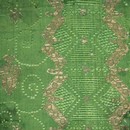
Figure 6 - Brocaded silk, woven with silver thread, France or Italy, 1690s. Museum no. 1077c-1888, photography by Alice Dolan
The silks used to decorate the Trouvain print may also date from the 17th century, as they have a high metal thread content, similar to the fabrics shown in figures 10-12. Again, it is possible to make comparisons between the design of the silks and those used to decorate the print. The scrolling stem and foliage motifs that characterise the silks in figures 10 and 11 are similar to those used on the mantua and the bottom of the petticoat on the Trouvain print, while the silk shown in figure 13 shares common design features with fabrics applied to both the Trouvain and the Subligny prints.
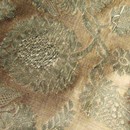
Figure 10 - Brocaded silk, France, 1660s. Museum no. T.132-1985, bequeathed by the late John Compton, photography by Alice Dolan
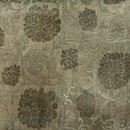
Figure 11 - Brocaded silk, possibly French, 1670-1690. Museum no. 1604-1900, photography by Alice Dolan
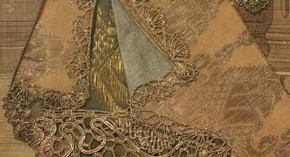
Figure 14 - Detail of engraving, Mademoiselle Subligny dansant a l’Opera, Jean Mariette (publisher), 1688-1709, hand coloured with applied silks and bobbin lace. Museum no. 1197-1875, given by Lady Wyatt, photography by Alice Dolan
Metal lace is a rare survival as it was often melted down for its precious metal content. Figures 14-16 show the bobbin lace used on the Subligny and Trouvain prints.
Both prints feature an identical thin scalloped bobbin lace, which was used to decorate the edges of the gowns and sleeves, perhaps suggesting that both prints were decorated by the same maker. Broad metal bobbin lace is used at the bottom of both petticoats. Figure 17 and figure 18 are examples of metal bobbin lace used in the late 17th and early 18th centuries. Figure 17 has thin scalloped edges similar to the thin bobbin lace in figure 14 and figure 16 although the broader bobbin lace used on the Subligny and Trouvain prints is more ornate than that pictured in figure 17 and figure 18. The trend for metal fringed petticoats in the 1690s supports the notion that these prints were decorated soon after publication, although it is possible, too, that decoration occurred at a later date using old textiles. (11)
One can only speculate on the origins of the fabrics used to decorate adorned prints. The pieces used may have been off-cuts from the production of a new dress or furnishing of a room, bought especially for the purpose, or scraps cut from old clothes. They may also have been pieces of fabric retained for future alterations, as suggested by the example of the Sixth Earl of Coventry. On 28 April 1779, William Morse, a tailor, charged the Sixth Earl for a series of alterations and repairs which include: ‘altering a suit olive green mixt cloth’, ‘altering a green velvet dress coat & breeches’, ‘d[itt]o to a tissue waistcoat & pieceing wider the [length?] & side’, ‘D[itt]o to a dress suit & spring velvet’ and ‘altering a buff silk waistcoat d[itt]o’. It would appear that the unfortunate Sixth Earl had put on weight and consequently needed his garments to be ‘piece[d] wider’. As he was only charged for silk serge and calico – the lining materials – it seems likely that Morse or the Earl had kept off-cuts or surplus fabrics for this very purpose. (12)
Elsewhere, the high cost of fabric explained its reuse in the decoration of prints. The Museum of London holds an adorned print of Marie Sophie Palatine, which was decorated with a blue-green silk woven with metal thread, which also features a fold with stitch marks on either side. (13) The reuse of textiles was common in the 18th century. Many goods were sold second-hand, including textiles. (14) According to Beverly Lemire, it was a ‘common feature’ of life across the social spectrum. There was a strong second-hand market for clothing and tailors ‘routinely’ sold their client’s second hand clothes. Although Lemire’s research focuses on the clothing owned by non-elites, it is possible that the scraps of silk used on the Mariette print were obtained from the second-hand clothes market. (15) Although alternative routes for the purchase of silks are difficult to trace, as Mercers’ advertisements in contemporary newspapers fail to mention craft materials or scraps of fabrics, larger pieces of fabric were bought for quilt making, cut up and made into patches, which means that it is not unlikely that smaller pieces of silk were also available through shops. (16)
Fashion plates and the dissemination of fashion in France and England
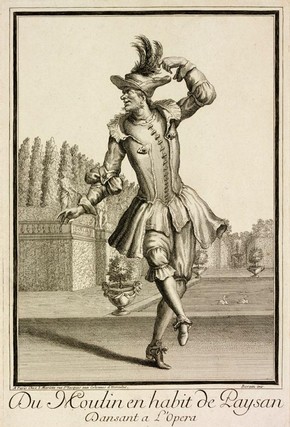
Figure 19 - Engraving, Du Moulin en habit de Paysan, Jean Mariette (publisher), Paris, about 1660-1742. Museum no. 4954-1968, given by Dame Marie Rambert
Although some historians have argued that prints of figures with detailed depictions of clothing were ‘fashion plates’, there is much scholarly disagreement about the genre. John Lea Nevinson has located the origins of the fashion plate in the 16th and early 17th centuries, while Aileen Ribeiro associates them with 17th century France. By contrast, Vyvyen Holland, D. Langley Moore and Neil McKendrick situate the development of the genre in late 18th century England. (17) Definitions of what actually constituted a fashion plate have also varied, with Ribeiro claiming they were only general representations, while McKendrick argued for their accuracy in depicting the detail of new fashions. Scholars are, however, unanimous in the belief that fashion plates functioned to inform people about fashions which they then emulated. (18)
Those historians who place the origins of the fashion plate in the 17th century stress the importance of images in the Mercure Galant, later named Le Nouveau Mercure Galant, a monthly periodical that featured articles about fashion. This publication included images of sumptuously dressed men and women, which were accompanied by descriptive text. Unlike Mariette’s print of Subligny, these were clearly intended to educate the viewer about fashion. The work of Jean Bérain (1640-1711), engraver and dessinateur de la Chambre du Roi, suggests that there were differences between fashion engravings and those showing theatrical costume. Bérain’s engravings for the Mercure Galant (1677-78) depicted suitable dress for the different seasons, but crucially included descriptive captions. (19) An engraving of the opera dancer Henri Du Moulin (fig. 19) signed Bérain, appears not to be a fashion plate, as it is not annotated and Du Moulin wears an opera costume. Rather than fit into the category of ‘fashion plate’, prints of opera dancers might best be classified as costume plates or prints depicting historical fashions, occasional dress or national costume. (20)
The Subligny print might best be considered, then, in the context of prints showing operatic subjects (fig. 2, figs. 19-21), such as Mademoiselle de Subligny danseuse de l'Opéra, produced by Henri Bonnart. Held by the Bibliothèque Nationale in Paris, the print showed the dancer in a pose reminiscent of Mariette’s print – stood by a window, with a column behind her, and both arms outstretched. Her costume is, however, markedly different. The Bonnart print depicts Subligny in sleeves and a bodice with scalloped edges, with fabric billowing from behind her head. She also has fewer jewels, which vary in size and in how they reflect the light. There are three layers to her skirt, with the top layer cut into an unusual shape, and incorporating neoclassical decoration, fringing and embroidery. Below this layer is a plain textile with fringing. The under-skirt is decorated with acanthus scrolls and sparsely placed jewels. (21) The Mariette and Bonnart prints may have been inspired by each other, but the differences in dress, faces and style of the work indicate that one did not copy the other: they are different interpretations of the same individual.
Mariette also produced other prints of personalities associated with the opera, such Subligny’s dance partner, Jean Balon, also after Bérain, Mademoiselle des Mastins (fig. 20) and Mademoiselle Moreau (fig. 21). Like the image of Subligny, des Mastins and Moreau were captioned with the phrase ‘dansant a l’Opera’, suggesting that Mariette may have published a set of prints of famous opera dancers. (22) The background in the Moreau print is similar to that in the Subligny, and because they are both ‘dancing’, it suggests that a theatre set is pictured behind both figures (fig. 2 and fig. 21). Subligny, Du Moulin and Mastins wear opera costumes (fig. 2, figs. 19-20). (23) These types of engravings cannot be categorised as ‘Les Modes’ - the contemporary term to describe engravings of allegorical and real individuals - which Madeleine Ginsburg defines as ‘always in fashionable dress’. (24) It is clear that neither Mastins nor Du Moulins are depicted in fashionable dress. Instead, these engravings reflected contemporary interest in the opera, just as interest in theatre and masquerades led to the production of images of the costumes, as in volumes such as Loüis Riccoboni’s Historie du Theatre Italien, 1728, and H. Le Comte, Costumes de theatre de 1670 à 1820. (25)
Historians have argued that ‘fashion’ or costume plates played an essential role in the promotion of French luxury clothing throughout Europe. Diana De Marly argues that ‘fashion engravings’ and the Mercure Galant were used in the late 17th century to disseminate French fashion abroad. (26) Ginsburg acknowledges that the profusion of ‘large-scale popular prints’ may have filled the gap between the first appearance of ‘illustrated fashion articles’ in the Mercure Galant in the 1670s and their next appearance in magazines in 1729, but she also lists ‘proxy’ information, such as observation and fashion dolls, as the most common means of learning of new fashions in the late17th century. (27) Ribeiro concurs with De Marly, stating that costume plates were descendents of the French luxury trades, depicting changing textiles and styles, ‘in response to the royal imperative decreeing the arts of fashion as an essential part of French cultural propaganda’, but, like De Marly, she recognises that they had uses other than the dissemination of fashion, providing the example of Pepys as a collector who considered these prints ‘works of art’ in their own right (28) Daniel Roche contends that engravings of dress by Bérain and the Bonnarts were ‘one of the signs of French hegemony in Europe’, and argues that these engravings eventually came to replace fashion dolls. (29)
It seems highly likely that French prints, such as the Subligny print, were popular with collectors due to their association with a fashionable culture, especially as imported prints were more common in England than English prints in this period. (30) French ballet and opera were hugely influential throughout Europe from the late 17th century, and although Louis XIV’s retirement from active participation in the ballet in 1670 reduced the prestige of dance within the court, he created the Académie Royale de Danse in 1661 and the Académie d’Opera in 1669 (later renamed the Académie Royale de Musique), which professionalized dance in France. Jennifer Homans posits that ballet was the ‘perfect artefact of 17th century French aristocratic culture’ with the ‘reminders of etiquette [...] imprinted in the steps’. (31) She contends that there was a deliberate attempt to ‘extend French influence’ throughout Europe, placing the Academy of Dance in the context of the other academies for painting, fencing, music and architecture. (32) Likewise, for Ivor Guest, the regulations introduced in 1713 to improve the administration of the Paris Opera confirmed it as ‘an institution of state and an official expression of French culture’. (33) These arguments echo those made by De Marly, Ribeiro and Roche, suggesting that it is, perhaps, more useful to consider engravings such the Subligny print as part of a broader attempt by France to permeate and even dominate the cultures of other European countries, rather than as disseminators of specific fashion advice.
And yet, English collectors were motivated by curiosity, rather than sycophancy to French culture, in their purchase of prints. Angela McShane and Claire Backhouse emphasise that the range of engraved subjects with detailed depictions of clothing ‘complicates’ theories of the emulation of prints. These prints provided information on ‘countries, people and customs’, and were used for decorating rooms, or were copied in order to practise drawing. (34) Prints were advertised in the late 17th and early 18th centuries as ‘curiously engraven’, a title applied to sheet music, copy books, maps, poems, images of monarchs, monuments and playing cards. (35) Pepys’ ownership of prints provides a valuable case study for attitudes to French engravings in the late 17th century. He owned costume plates that could be termed fashion plates as well as many other types of prints. His collection of sixteen prints, labelled the Habits de France d’environ l’Année 1670 initially suggests that Pepys has assembled this series to garner information about the newest fashions, but this assumption is challenged by the wider context of his collecting practices, as Pepys did not make regular collections of dated sets. The next two sets showing Parisian clothing cover the period between 1688 and 1695. Pepys also owned costume plates, catalogued as ‘HABITS’, which included historical figures, Oxford academic dress, previous monarchs and allegorical prints. These showed dress from 1640 although he only started collecting prints in the 1660s. (36) He owned ‘Habits. of both Sexes and of Divers Countrys and Ages’, which include Roman, European, Middle Eastern, African and Indian clothing. In addition, Pepys owned three sets of the ‘cryes’ of London and one set of ‘les cris de Paris’ that depict figures in great detail. (37) This pattern of ownership suggests that it was the desire to collect rather than emulate French fashions that inspired Pepys’ acquisition of French engravings, challenging the assumption that these images were ‘fashion plates’. (38)
Furthermore, there were much more effective and practical ways of disseminating information about clothing than through prints, adorned or otherwise. Design information was often conveyed by the written and spoken word, while purchases of clothing were routinely made by proxy. (39) Even in the late 18th century, the written word was still important for the transmission of information about objects. In 1793, the engineer and manufacturer Matthew Boulton wrote to his buckle-maker, ‘As you and I shall often have occasion to speak of forms and proportions of buckles, it is necessary we should settle a distinct language of visual description’. (40) The use of images was even unusual in periodicals like the Mercure Galant, where text remained the primary medium for discussion of changing fashions in textiles and accessories. This can be attributed to the high costs incurred in producing images. And finally, looking at what other people were wearing often superseded the usefulness of prints. On 4 May 1662, the ever-observant Pepys walked with his wife ‘to Grays Inn, to observe fashions of the ladies, because of my wife's making some clothes’. (41)
Female leisure and the adorned print
The context of female domestic craft may offer the most likely explanation for who decorated the Subligny print, and why. It also offers explanation for why it so difficult to locate modified prints in contemporary documents. In addition to the hybrid construction of the prints themselves, their absence from contemporary sources could also be linked to the typical exclusion from contemporary sources of ‘women’s work’, if not the women who made them.
Pepys provides crucial evidence regarding the modification of prints in 17th century England. These prints were often used to decorate the home, where they were a huge source of pleasure. Satirical prints made people laugh, while others would beautify or inform. On 2 July 1662, the diarist spent ‘all morning dressing my closet at the office with my plates very neatly, and a fine place now it is, and will be a pleasure to sit in’. He varnished his prints to protect them, a common practice which eventually caused their destruction. (42) Contemporary English newspapers also advertised prints that could be used to decorate a range of items including tobacco boxes, cabinets, baskets, screens, chimneypieces, closets and studies. (43)
Pepys also encouraged his wife, Elizabeth, to engage in similar activities. (44) On 7 November 1666, Pepys bought ‘prints for my wife to draw by this winter’. (45) To ‘draw’ the prints could imply copying them, or it could indicate that she coloured them in. A number of the prints in the section of ‘Habits de France’ have contemporary hand colouring. In some instances, Pepys owned two copies of the same prints, such as ‘Mademoiselle d'Armagnac’ published by Antoine Trouvain in 1695, and the extra copies have been hand-coloured. (46) Roger Chartier stresses the intimate relationship that individuals had with print within their homes: prints ‘penetrated their private world, mobilizing their sentiments, fixing their memories and guiding their habits’. (47) That Pepys and his wife took pleasure in and modified contemporary prints demonstrates that prints were not just for gazing at, but were used to beautify the home.
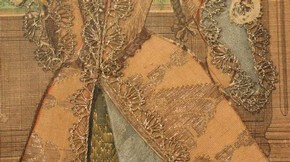
Figure 23 - Detail of gown and the bottom of left sleeve, Mademoiselle Subligny dansant a l’Opera, Jean Mariette (publisher), 1688-1709. Museum no. 1197-1875, given by Lady Wyatt, photography by Alice Dolan
Adorned prints, like the Subligny print, are also examples of another type of domestic craft, cut-paper work. In figure 22 we see how the areas outlined in black are from the engraving, with thin lines of paper kept to maintain the outlines and drapery of the original print. Cut-paper work (découpure in French), was one of a plethora of domestic craft activities undertaken by women in the 18th century. (48) Anna Maria Garthwaite, the silk designer, produced the example shown in figure 22 in 1707 at the age of seventeen. Although her work is much more accomplished than the adorned prints considered by this paper, the tree on the left, towards the centre of her composition, has leaves formed out of black feathers, which is not dissimilar to the use of textiles in the Subligny print.
Understanding the pride and emotional attachment that women invested in their cut-paper work also enriches our reading of the Subligny print. Mrs Delany, a gentlewoman, recalled in about 1740 that as a young woman she ‘took great delight in a closet I had, which was furnished with little drawings and cut paper of my own doing; I had a desk and shelves for my books’. Her work brought her great personal satisfaction and held significance for others too. She recalled a Mr Twyford, who became depressed because he could not marry her. On his death ‘they found under his pillow a piece of cut paper, which he had stolen out of my closet at the Farm’. (49) The use of expensive silks with metal threads also suggests the high value placed on these objects. Modified prints could have been used to decorate the home or be brought out for friends to admire. Both the Subligny and Trouvain prints were decorated with silks with metal threads, and would have come alive in candlelight, as figure 24 and figure 25 illustrate. The adornment of these prints therefore enhanced the decorative function of the original engraving, allowing it to enhance a room during the day and at night.
Decorating Subligny’s print could be regarded as an act of homage by one of the dancer’s many admirers. Her celebrity status clearly made it financially worthwhile for Mariette to publish her portrait as an engraving. As Judith Milhous convincingly argues, foreign opera dancers were huge celebrities in England and attracted sizeable audiences when they performed there. (50) Subligny’s visit to London to perform in the winter of 1701-02 was deemed remarkable enough to feature in a periodical published over two years later in 1704. (51) Her reputation was duly reflected by high earnings. While the architect and dramatist Sir John Vanbrugh estimated the annual cost of keeping seven dancers in 1703 as £500, Mademoiselle Subligny received in the region of £420 to dance during her five-week stay in England. (52) It was France, however, where she danced for most of her professional life, receiving from L’Academie Royale de Musique an annual salary of 1500 livres, around £112. 10s., by 1713. This was 800 livres more than the next highest salary for the female opera dancers, showing just how extraordinary she was by contemporary standards. (53)
Like all the domestic crafts, cut-paper work was censured by contemporaries. Alexander Pope’s poem ‘On the Countess of Burlington Cutting Paper’ offered the following critique: ‘Alas! One bad example shown, / How quickly all the sex pursue! / See, madam, see the arts o'erthrown / Between John Overton and you!’. (54) Pope’s reference to the publisher John Overton could be read as an attack on the increasing popularity of the print as a domestic object. In 1741, the bluestocking Elizabeth Robinson Montagu, referred to this poem in a letter where she described her domestic and writing activities, remarking that ‘some of my employments are of the same importance as cutting paper; indeed, for me you should read blot paper rather than cut paper’. (55)
Conclusion
It seems likely that the Subligny print should not be categorized as a fashion plate. It did not share the explicitly didactic function of that genre and, as we have seen, there were other more effective ways to transmit information about fashion. Instead, as one of a number of engravings of opera dancers, it should be seen as part of a broader French attempt to influence the culture of other European countries, as French prints of ballet and opera stars were routinely imported into 17th century England. More specifically, the Subligny print is an example of an adorned print. Employing similar construction techniques to cut-paper work, it is likely that these prints were bought for and adorned by wealthy women in the home, either in England or in France, and then used to enhance the domestic environment and to display their virtuous accomplishments. Perhaps Subligny’s fame as a celebrated dancer suggests that the engraving was also partly decorated as an act of homage. At the same time, this study of the V&A’s Subligny print may open new avenues for research. Without scientific analysis of the pigments used to colour the print, it has not been possible to date the decoration of the Subligny print conclusively, but a strong case can be made for the likelihood of its decoration before the 19th century. Nevertheless, it is still compelling to ask why 17th century French engravings were decorated in the 19th century as the items in the V&A’s ‘Bonnart album’ definitely were.
Endnotes
(1) Cumming, Valerie. A Visual History of Costume: The Seventeenth Century . London: B.T. Batsford, 1984: plate 148; Nevinson, John Lea. 'Origin and Early History of the Fashion Plate'. United States National Museum Bulletin. 250. Washington, D.C.: Smithsonian Press, 1967: 67-91; Ribeiro, Aileen. Fashion and Fiction: Dress in Art and Literature in Stuart England. London: Yale University Press, 2005: 289.
(2) The Pierpoint Morgan Library (New York) and the Museum of Fine Arts (Boston), use the term ‘dressed plates’.
(3) The Pierpoint Morgan Library (New York) and the Museum of Fine Arts (Boston), use the term ‘dressed plates’.
(4) Griffiths, Anthony. The Print in Stuart Britain, 1603-1689. London: British Museum, 1998: 19, 110 & 198.
(5) Martin, Henri-Jean. Print, Power and People in Seventeenth-century France. Translated by David Gerard. London: The Scarecrow Press, 1993: 497; Globe, Alexander. Peter Stent: London Print Seller circa 1642-1665. Vancouver: University of British Columbia Press, 1985): 7 & 136-38.
(6) Wheatley, H. B. Particulars of the life of Samuel Pepys. London: George Bell & Sons, 1893, http://www.pepysdiary.com/intro/pepys/ (para. 16), [accessed 07/01/2010]; Latham Robert (ed.). Catalogue of the Pepys Library at Magdalene College Cambridge. 7 vols. Cambridge: D.S. Brewer, 1994: xiii, 57-58, 87, 100, 112, 142, 171, 173, 175.
(7) V&A Museum no. E.826 to E.845-1900, the album includes prints published or designed by Nicholas Bonnart (c.1637-1718), publisher; Robert Bonnart (1652-1729), printmaker; Jean Dieu de St Jean (1655-c.1695), printmaker; P. Valran; Jean Mariette and Antoine Trouvain.
(8) Rutherston, Jane. Fashion and the Luxury Goods Market under Louis XIV. Unpublished MA dissertation, V&A /Royal College of Art, 1996: 23; Jane Rutherston, internal museum notes on the conservation of the Bonnart album, E.826-845-1900 (1996). The Museum of London, Museum of Fine Art (Boston) and the Pierpoint Morgan Library (New York) also hold decorated or dressed prints.
(9) These issues were discussed in personal correspondence with Clare Browne, V&A Museum senior textiles curator, 03/12/2010 to 09/12/2010.
(10) V&A Textile Drawers 1186 to 1198, viewed 04/01/2010.
(11) Angela McShane and Clare Backhouse, 'Top Knots and Lower Sorts: Print and Promiscuous Consumption the 1690s' in Printed Images in Early Modern Britain: Essays in Interpretation edited by Michael Hunter. Ashgate: Aldershot, 2010: 348-9.
(12) Worcester County Record Office, reference number 705:73, BA number 14450, box number 40, bundle 33, bill 14b; Dolan, Alice. Reassessing the aristocratic male consumer: the Sixth and Seventh Earls of Coventry and their clothes, 1759-1830. Unpublished BA dissertation, Royal Holloway, University of London, 2009: 42.
(13) 'Marie Sophie Palatine, Reyne de Portugal', engraving, G. Valek, decorated by unknown, 1694. Museum of London, 2002. 139/356.
(14) Coquery, Natcha. 'The Language of Success: Marketing and Distributing Semi-Luxury Goods in Eighteenth-century Paris'. Journal of Design History.17:1 (2004): 71-89.
(15) Lemire, Beverly . 'Consumerism in Preindustrial and Early Industrial England: The Trade in Secondhand Clothes'. The Journal of British Studies. 27:1 (January 1988): 1-24.
(16) For example, 'Advertisement'. Spectator. 8: 613 (27 October, 1714): 1188, see entry for Richard Chamberlayne; 'Advertisement'. London Journal. 220 (12 October, 1723): 4, see George Wise; 'Advertisement'. Universal Spectator. 470 (8 October, 1737): 1370, see Thomas Hinchcliff; Angela McShane, Ann Christie, Abigail Turner, 'The Chapman Coverlet: texts, myths and mysteries' in Quilts 1700-2010: Hidden Histories, Untold Stories, edited by Sue Pritchard. London: V&A Publishing, 2010: 125-126.
(17) Holland, Vyvyen. Handcoloured Fashion Plates 1770-1899. London: B.T. Batsford Ltd., 1981; Langley Moore, D. Fashion through Fashion Plates 1771-1970. London: Ward Lock, 1971: 12; McKendrick, Neil. 'The Commercialization of Fashion' in The Birth of a Consumer Society: The Commercialization of Eighteenth-Century England edited by Neil McKendrick, John Brewer and J.H. Plumb. London: Europa Publications Limited, 1982: 47-48; Nevinson. Origin and Early History of the Fashion Plate, 67-78; Ribeiro claims that fashion plates could ‘more accurately’ be called ‘costume plates’; despite this she continues to use the term ‘fashion plate’; Fashion and Fiction, 18-19. This type of misuse of the term is common, for example it also occurred at Nicholson, Kate. Refashioning Fashionability: Women’s Portraiture, Fashion Prints, and Allegory in France at the Turn of the 18th Century. Art History Research Seminar, University College London, 13 January 2010.
(18) See for example, De Marly, Diana. Louis XIV & Versailles. London: B.T. Batsford Ltd., 1987: 47-48; McKendrick, Neil. 'The Commercialization of Fashion' in The Birth of a Consumer Society: The Commercialization of Eighteenth-Century England edited by Neil McKendrick, John Brewer and J.H. Plumb. London: Europa Publications Limited, 1982: 47; Ribeiro, Aileen. Fashion and Fiction: Dress in Art and Literature in Stuart England. London: Yale University Press, 2005: 19.
(19) Gaudriault, Raymond. La Gravure de mode feminine en France. Paris: Editions de l'Amateur, 1983: 18.
(20) Holland. Handcoloured Fashion Plates, 22; Langley Moore. Fashion Through Fashion Plates, 10; Ribeiro, Aileen. Fashion and Fiction: Dress in Art and Literature in Stuart England. London: Yale University Press, 2005: 18-19.
(21) Mademoiselle de Subligny danseuse de l'Opéra, Henri Bonnart, eighteenth century. Bibliothèque Nationale, Paris, EST RESERVE QB-201 (74)-FOL. It can be viewed online through their online image search: http://visualiseur.bnf.fr/Visualiseur?Destination=Daguerre&O=31008072&E=JPEG&NavigationSimplifiee=ok&typeFonds=noir; Hilton, Wendy. Dance of Court and Theatre: French Noble Style, 1690-1725. London: Dance Books, 1981: 38.
(22) Spotlight: four centuries of ballet costume, a tribute to the Royal Ballet. London: V&A, 1981: 18.
(23) Spotlight, 17; Fowler, James. 'Archives of the Dance: Early Dance Holdings of the Theatre Museum, London' in Dance Research. 7:2 (Autumn, 1989): 84.
(24) Ginsburg, Madeleine. An Introduction to Fashion Illustration. London: V&A/The Compton Press, 1980: 6.
(25) Lipperheide, F.J.. Katalog der Freiherrlich von Lipperheide’schen Kostümbibliothek. 2 vols. Berlin: F.J. Lipperheide, 1896-1905, vol. 2: 475; 482.
(26) De Marly, Diana. Louis XIV & Versailles. London: B.T. Batsford Ltd., 1987: 47; 53.
(27) Ginsburg, Madeleine. An Introduction to Fashion Illustration. London: V&A/The Compton Press, 1980: 5-6.
(28) De Marly, Diana. Louis XIV & Versailles. London: B.T. Batsford Ltd., 1987: 53; Ribeiro. Fashion and Fiction, 19; 257.
(29) Roche, Daniel. The Culture of Clothing: dress and fashion in the ‘ancien régime’. Translated by Jean Birrell. Cambridge: Cambridge University Press, 1994: 14; 475.
(30) Griffiths, Anthony. The Print in Stuart Britain, 1603-1689. London: British Museum, 1998: 19.
(31) Guest, Ivor. The Paris Opera Ballet. Dance Books UK, 2006: 5-6; Homans, Jennifer. Apollo’s Angels: A History of Ballet. New York: Random House, 2010: 15; 25; 40; 47-48.
(32) Homans, Jennifer. Apollo’s Angels: A History of Ballet. New York: Random House, 2010: 18-19.
(33) Guest, Ivor. The Paris Opera Ballet. Dance Books UK, 2006: 12.
(34) Angela McShane and Clare Backhouse, 'Top Knots and Lower Sorts: Print and Promiscuous Consumption the 1690s' in Printed Images in Early Modern Britain: Essays in Interpretation edited by Michael Hunter. Ashgate: Aldershot, 2010: 332-33.
(35) For example, 'PROPOSALS'. Records of Love. 14 February, 1710: 112; 'Advertisement'. Daily Courant. 1140 (8 December, 1705): 2; 'Advertisement'. Athenian Gazette. 5:18 (30 January, 1692): 18; 'Advertisement'. Observator. 7:3 (25 February, 1708): 402; 'Advertisement'. Lucubrations of Isaac Bickerstaff, Esq.. 17 (19 May, 1709): lxvi; 'Advertisement'. Observator. 9:33 (10 May, 1710): 952; 'Advertisement'. Lucubrations of Isaac Bickerstaff, Esq.. 221 (7 September, 1710): dcxxxviii; 'Advertisement'. British Apollo, or, Curious amusements for the ingenious / perform'd by a society of gentlemen. 83 (26 November, 1708): 340.
(36) Latham. Catalogue of the Pepys Library. xiii; 31-4; 57-8; 254.
(37) Latham, Catalogue of the Pepys Library. 34; 58-9; 218-20; 222-26; 229-31; 278. Other examples include Roman Catholic vestments, monarchs, aristocrats, and soldiers were also categorised as ‘HABITS’, Parisian artisans, hairstyles, accessories and foreign clothing.
(38) De Marly, Diana. 'Pepys and the Fashion for Collection'. Costume. 21 (1987): 34-35.
(39) Vickery, Amanda. 'Women and the World of Goods: A Lancashire Consumer and her Possessions, 1751-81', in Consumption and the World of Goods edited by J. Brewer and Roy Porter. London: Routledge, 1994: 278; 280; Vickery, Amanda. The Gentleman’s Daughter. London: Yale University Press, 2003: 164-65; 361; Vincent, Susan. '"Please can you obtain for me?": shopping by proxy'. Distribution Networks for Textiles and Dress, c. 1700-1945. CHORD/Pasold Conference, University of Wolverhampton, 8 September 2010.
(40) Styles, John. 'Manufacturing, Consumption and Design in Eighteenth-Century England' in Consumption and the World of Goods, 545-46.
(41) Pepys, Samuel. The Diary of Samuel Pepys. (4 May 1662) edited by Richard Griffin Braybrooke. Project Gutenberg, 2003, http://www.gutenberg.org/dirs/4/2/0/4200/4200.txt [accessed 23/12/2009].
(42) Latham. Catalogue of the Pepys Library. Vol 3: xiii.
(43) Griffiths, Anthony. The Print in Stuart Britain, 1603-1689. London: British Museum, 1998: 29.
(44) Latham. Catalogue of the Pepys Library. For example, 57.
(45) Angela McShane and Clare Backhouse, 'Top Knots and Lower Sorts: Print and Promiscuous Consumption the 1690s' in Printed Images in Early Modern Britain: Essays in Interpretation edited by Michael Hunter. Ashgate: Aldershot, 2010: 354, no. 23.
(46) Latham. Catalogue of the Pepys Library. xv; 254-56. Elizabeth began drawing lessons in 1665.
(47) Chartier, Roger. The Cultural Uses of Print in Early Modern France. Translated by Lydia G. Cochrane. Princeton, New Jersey: Princeton University Press, 1987: 233.
(48) Boyer, Abel. Dictionaire Royal, françois-anglois, et anglois-françois. 2 vols. Amsterdam, 1727: 1.
(49) Delany, Mary Granville Pendarves. 'Letter from Mary Granville Pendarves Delany to Lady Margaret Cavendish-Harley Bentink, Duchess of Portland, 1740[?]' in The Autobiography and Correspondence of Mrs Delany edited by Sarah Chauncey, 2 vols. Boston, MA: Roberts Bros., 1879, vol. 1: 11; 24.
(50) Milhous, Judith. 'The Economics of Theatrical Dance in Eighteenth-Century London'. Theatre Journal. 55:3 (October 2003): 485-486.
(51) Untitled. Diverting Post. 8 (16 December, 1704): 28; Milhous, 'The Economics of Theatrical Dance', 485.
(52) Milhous, 'The Economics of Theatrical Dance', 485; 487. Ballon is supposed to have received this fee and an additional £105. Subligny received a similar fee.
(53) de La Gorce, Jerome. 'L'Academie Royale de Musique en 1704: d'apres des documents inedits conserves dans les archives notariales'. Revue de Musicologie. 65:2 (1979): 174-76; Lecomte, 'The female ballet troupe’, 116; ‘The Marteau Early 18th Century Currency Converter’, Pierre Marteau Platform of Research in Economic History, http://www.pierre-marteau.com/currency/converter/fra-eng.html [accessed 10/10/2010]. The exchange rate used is 3l. to 40 livres; Spotlight, 17.
(54) Pope, Alexander. 'On the Countess of Burlington Cutting Paper' in The Works of Alexander Pope: with a memoir of the author, notes and critical notices on each poem edited by Reverend G. Croly. 4 vols. London: A.J. Valpy, 1835, vol. 4: 153.
(55) Montagu, Elizabeth Robinson. 'Letter from Elizabeth Robinson Montagu, 1741' in The Letters of Mrs. E. Montagu, With Some of the Letters of Her Correspondence. 2 vols. London: T. Cadell and W. Davies, 1809, vol. 2: 63; Vickery. Behind Closed Doors: At Home in Georgian England. London: Yale University Press, 2009: 246.
Issue No. 3 Spring 2011
- Editorial
- Promoting corporate environmental sustainability in the Victorian era: The Bethnal Green Museum permanent waste exhibit (1875-1928)
- ‘Nothing of intrinsic value’: The scientific collections at the Bethnal Green Museum
- Shedding light on the digital dark age
- John Thomas and his ‘wonderful facility of invention’: Revisiting a neglected sculptor
- Dialogues between past and present: Historic garments as source material for contemporary fashion design
- Kütahya ceramics and international Armenian trade networks
- X-radiography as a tool to examine the making and remaking of historic quilts
- A patchwork panel ‘shown at the Great Exhibition’
- An adorned print: Print culture, female leisure and the dissemination of fashion in France and England, around 1660-1779
- Seating and sitting in the V&A: An observational study
- Review: The Actor in Costume by Aoife Monks
- Review: Not quite Vegemite: An architectural resistance to the icon
- How to submit a proposal to the V&A Online Journal
